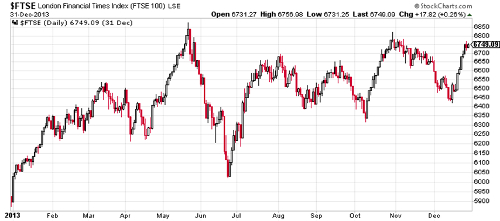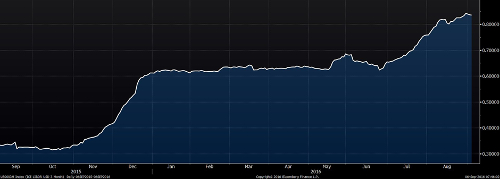The summer ceasefire in the markets is over. The war – against deflation, against savers and against cash – is hotting up again. But which monetary generals are fighting the last war? And which front line is about to collapse, leading to a retreat in the bond market and a sneak attack on stocks?
You’ll have to excuse all the military metaphors and analogies. It’s a weakness of mine. But today I want to share three signals from the market that may indicate a turning point in markets. The turning point is that quantitative easing as we know it has been an unqualified failure. A retreat could be signalled this month. The retreat from more QE would be a major change in the status quo.
Let’s start with the Pacific Theatre in the war on deflation. Remember a few months ago when Bank of Japan governor Haruhiko Kuroda promised a “comprehensive” review of Japan’s QE programme? Well that review is due out on 21 September .
And here’s the important point: the review could announce a retreat from QE and trigger some big changes in capital flows.
By that I mean the bursting of the bond bubble and massive volatility in stocks and gold. That’s worth thinking about if you’re an investor. So let’s think about it some more, shall we?
Japan’s phased withdrawal from QE (a taper and its tantrum)
The bond market is telling you to expect a retreat from QE in Japan. Tim Price sent me an article this morning showing that Japanese government bonds (JGBs) had their worst month since 2010. Investors are selling longer-dated government debt ahead of the release of this month’s “comprehensive review”.
Thirty-year JGB bond prices are down 12.5% since July, when yields cratered at .05%. Thirty-year yields are now around 0.53%. Mind you, that’s not a huge yield. But it tells you that investors are behaving as if the Bank of Japan may no longer buy bonds to drag yields down across the length of the Japanese yield curve. Ten-year yields even made a brief attack on positive territory last week, rising to negative .02%. Nearly positive yields on ten-year JGBs! The madness!
You may not be as casually interested in the Japanese bond market as I am. But it matters because of the chart below. Why? If the BoJ retreats from QE and no longer pushes down long-term bond yields, bonds could sell off. Government bonds. Corporate bonds. All of them. And it’s not straight forward to assume that stocks will directly benefit if investors sell bonds. Have a look below.

Back when General Ben S Bernanke was in charge of the Army of the Potomac – in May 2013 – he advised markets that the Federal Reserve would “taper” its bond purchases. It was a planned retreat from supporting financial markets. It was the equivalent of the Fed declaring victory and going home.
You can see how the FTSE 100 reacted
The index fell 9% in just over month. The reaction was similar on other stockmarkets. It forced the Fed into an about-turn and the lesson was learned. Weep and wail loud enough and the central banks will keep the free and easy cash flowing. The Fed got even more deeply involved in markets and, like other central banks, has escalated to the point that the mere hint of withdrawal is enough to cause falling prices.
What about Japan? If Kuroda announces a strategic retreat from QE now, it will be met with falling bond prices. Unless.
Unless the bank simultaneously announces some other new front in the war on deflation. This is Japan, remember. It ’s been fighting this war for over 20 years. Just because massive QE doesn’t work, doesn’t mean the war is over.
The latest scuttlebutt (wire service reports) is that the BoJ will no longer target bond yields. That strategy – to lower borrowing costs and increase lending and investment – has been an unqualified failure. Time to change strategies!
The new strategy is to target nominal GDP growth, wages and incomes. This means you can allow long-term bond yields to rise – which rehabilitates profits in the financial sector by improving interest margins – while keeping short-term rates low. Or taking them even further negative.
It probably means a lot more than this
But we don’t know yet what GDP-targeting with monetary policy means, exactly. Does it mean helicopter money? Does it mean bigger government deficits? Does it mean a more direct attack on savers and pensioners by going after cash?
It could mean any of those things. It could mean all of them. All we know for sure right now is that the drums from the bond market are beating a retreat. In Japan, that could result in massive reallocations of capital to stocks. Tim’s been looking for just this sort of thing in The Price Report, via exposure to Japanese stock funds.
But in the wider war, and to the extent that everything happens in Japan first and elsewhere later, you have clear signs that the “endgame” for QE as we know it is well and truly upon us. The retreat from long-term bonds is orderly so far. But if it turns into a rout… watch out.
The ECB’s failed invasion
General Draghi, in command of the European front, has sent his trillion-strong army of euros into the market. Let’s hope they go to their gold like a soldier. They haven’t done much good for anyone else.
I’m referring to the €1 trillion in bonds the European Central Bank has bought since it began its own war on deflation 18 months ago. The ECB passed the €1 trillion level last week, according to data released this week. And like in Japan, it has little to show for its efforts – other than a bloated balance sheet and a sullied reputation.
The ECB’s board meets on Thursday. Among the items on the agenda: should it extend its bond-buying programme another six months beyond the scheduled expiration in March of 2017? And if so, what else can the ECB buy in order to appear like it’s doing something useful?
The trouble is the bank has too many troops and not enough front. Since inception, the ECB has bought €238 billion worth of German government bonds, €189 billion worth of French government bonds, and €164 billion worth of Italian government bonds. Inflation in the eurozone sits at 0.2%.
When you’re buying bonds and you own a printing press, money is quite literally no object. It’s nothing. It’s a fiction. There are no theoretical limits to how much money the ECB can “print” to buy bonds. The only limits are the size of the bond market and the limits policy makers have imposed on themselves.
The ECB’s “capital key” limits government bond purchases in a member country to a ratio of GDP. The ECB could simply relax that restriction and buy all of Germany’s bonds, all of France’s bonds, and all of Italy’s bonds. But to what end?
That’s really the point
The ECB could buy all the government and corporate bonds in the eurozone. But all it would do is further distort already dysfunctional markets. You can drop a bomb on a crater. But all you do is make a bigger hole in the ground. And by bigger, I don’t mean better.
It’s the same problem with retreating on QE but ordering carpet bombing on wages and incomes. Helicopter drops are indiscriminate. And targeting nominal GDP growth is even cruder than QE. It’s a brute force printing press hack to produce growth for its own sake.
Not quality. But quantity at any price. And the price is likely to be inflation (the kind that destroys your savings and your quality of life more quickly than you can imagine).
Are you beginning to see why these generals are so dangerous? Their bullets cost them nothing. But their strategies and tactics cost savers, pensioners, and investors real income, real wealth, and real quality of life. And sadly, it’s likely that the attack on your well being will get more direct and forceful in the future.
Libor surges

The third signal I want to (briefly) share with you is a rise in short-term borrowing costs for corporations. Three-month US dollar Libor is on the rise. You can see it in the chart above. Last time this happened, Libor signalled a collapse of trust and liquidity in the money market (a key source of short-term funds for corporations) and in the interbank lending market.
I don’t think the same thing is happening this time around. But it’s an important signal all the same.

Category: Central Banks

